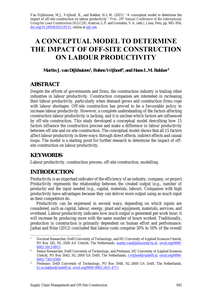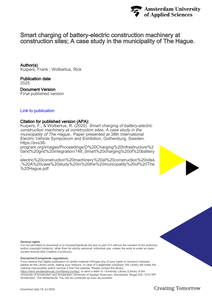Despite the efforts of governments and firms, the construction industry is trailing other industries in labour productivity. Construction companies are interested in increasing their labour productivity, particularly when demand grows and construction firms cope with labour shortages. Off-site construction has proved to be a favourable policy to increase labour productivity. However, a complete understanding of the factors affecting construction labour productivity is lacking, and it is unclear which factors are influenced by off-site construction. This study developed a conceptual model describing how 15 factors influence the construction process and make a difference in labour productivity between off-site and on-site construction. The conceptual model shows that all 15 factors affect labour productivity in three ways: through direct effects, indirect effects and causal loops. The model is a starting point for further research to determine the impact of off-site construction on labour productivity.
MULTIFILE

The growth in urban population and economic upturnis leading to higher demand for construction, repairand renovation works in cities. Houses, public utilities,retail spaces, offices and infrastructure need toadapt to cope with the increasing number of residentsand visitors, urban functions and changing standards.Construction projects contribute to more attractive,sustainable and economically viable urban areas oncethey are finished. However, transport activities relatedto construction works have negative impacts on thesurrounding community if not handled appropriately.It is estimated that 15 to 20 percent of heavy goodsvehicles in cities are related to construction, and 30to 40 percent of light commercial vans [1]. In the citiesstudied in the CIVIC project, construction-relatedtransport was found to be one of the biggest challengesto improving sustainability. Smarter, cleaner and saferconstruction logistics solutions in urban areas areneeded for environmental, societal and economicreasons. However, in many European cities and metropolitanareas the sense of urgency is not evident or alack of knowledge is creating passivity.
DOCUMENT

The labor productivity of construction projects is low. This urges construction companies to increase their labor efficiency, particularly when demands grow and labor is scarce. This blog introduces an overview that helps practitioners identify causes of low productivity to find and eliminate the root causes.
LINK
A large share of urban freight in cities is related to construction works. Construction is required to create attractive, sustainable and economically viable cities. When activities at and around construction sites are not managed effectively, they can have a negative impact on the cities liveability. Construction companies implementing logistics concepts show a reduction of logistic costs, less congestion around the sites and improved productivity and safety. The client initially sets the ‘ground rules’ for construction in the tendering process. This paper explores how tendering for construction projects can support sustainable urban construction logistics. We explore the potential for tendering construction projects, by both public and private clients, for sustainable urban construction logistics and we present a conceptual framework for specifying ‘logistics quality’ as a quality criterion for EMAT (Economically Most Advantageous Tender). Our exploration results in questions for further research in tendering for sustainable urban construction logistics.
DOCUMENT
Abstract: Last few years the hindrance, accidents, pollution and other negative side effects of construction projects and namely construction transport have become an issue particularly in urban areas across Europe such as in London, and in the Netherlands as well, including the cities of Utrecht, Rotterdam and Amsterdam. Municipalities have issued new legislation and stricter conditions for vehicles to be able to access cities and city centres in particular and accessibility of older and polluting vehicles. Considerate clients, public as well private, have started developing tender policies to encourage contractors to reduce the environmental impact of construction projects. Contractors and third party logistics providers have started applying consolidation centres. These developments have shown considerable reductions of number of vehicles needed to deliver goods and to transport workers to site. In addition these developments have led to increased transport efficiency, labour productivity and cost reductions on site as well as down the supply chain. Besides these developments have led to increased innovations in the field of logistics planning software, use of ICT , and handling hardware and equipment. This paper gives an overview of current developments and applications in the field of construction logistics in the Netherlands, and in a few project cases in particular. Those cases are underway as part of an ongoing applied research project and studied by using an ethnographic participative action research approach. The case findings and project results show initial advantages how the projects, the firms involved and the environment can profit from the advancement of logistics management leading to reduced environmental impact and increased efficiencies of construction transport.
DOCUMENT

from the article: "Abstract The way in which construction logistics is organised has considerable impact on production flow, transportation efficiency, greenhouse gas emissions and congestion, particularly in urban areas such as city centres. In cities such as London and Amsterdam municipalities have issued new legislation and stricter conditions for vehicles to be able to access cities and city centres in particular. Considerate clients, public as well private, have started developing tender policies to encourage contractors to reduce the environmental impact of construction projects. This paper reports on an ongoing research project applying and assessing developments in the field of construction logistics in the Netherlands. The cases include contractors and third party logistics providers applying consolidation centres and dedicated software solutions to increase transportation efficiency. The case show various results of JIT logistics management applied to urban construction projects leading to higher transportation efficiencies, and reduced environmental impact and increased production efficiency on site. The data collections included to-site en on-site observations, measurement and interviews. The research has shown considerable reductions of vehicles to deliver goods and to transport workers to site. In addition the research has shown increased production flow and less waste such as inventory, waiting and unnecessary motion on site."
DOCUMENT

The Design-to-Robotic-Production and -Assembly (D2RP&A) process developed at Delft University of Technology (DUT) has been scaled up to building size by prototyping of-site a 3.30 m high fragment of a larger spaceframe structure The fragment consists of wooden linear elements connected to a polymer node printed at 3D Robot Printing and panels robotically milled at Amsterdam University of Applied Science (AUAS). It has been evaluated for suitability for assembly on-site without temporary support while relying on human-robot collaboration. The constructed architectural hybrid structure is proof of concept for an on- and off-site D2RP&A approach that is envisioned to be implemented using a range of robots able to possibly address all phases of construction in the future.
DOCUMENT

From the article: "Project execution in the construction industry faces major challenges, e.g. difficulty in coordination and cooperation. Operational procurement during project execution is no exception. In this paper we construct a maturity model, based on earlier work, consisting of six dimensions (goal, control, process, organization, information, technology) and five maturity stages (transactional-oriented, commercial-oriented, coordination, internal-optimized, external-optimized). The model can be used to determine the level of procurement maturity for each of the dimensions, and for the determination of a strategy for growth in the construction industry. With input from a major construction firm in the Netherlands, through simulating tooling, the model is evaluated for its contribution to growth in operational excellence. Results of the simulation show support for a relation between maturity growth and increased operational excellence." Recommended Citation Xing, Xiaochun; Versendaal, Johan; van den Akker, Marjan; and De Bevere, Bastiaan, "Maturity of Operational Procurement in the Construction Industry: A Business/IT-Alignment Perspective" (2011). BLED 2011 Proceedings. Paper 22. http://aisel.aisnet.org/bled2011/22 Affiliation: Xing Xiaochun - Swets Information Services, Netherlands; Johan Versendaal - Utrecht University, Netherlands; HU University of Applied Sciences, Netherlands; Marjan van den Akker - Utrecht University, Netherlands; Bastiaan De Bevere - Ballast Nedam, Netherlands.
MULTIFILE

This paper investigates smart charging strategies for battery-electric construction machinery (non-road mobile machinery, NRMM) through a case study of a large-scale housing project in The Hague, Netherlands. The study develops a methodology to estimate energy demands and simulate charging profiles during various construction phases. Using a combination of smart charging and temporary battery storage, the paper demonstrates that peak grid loads can be significantly reduced—by up to 46%—compared to conventional charging strategies. Simulations reveal that grid limitations, especially during early construction phases, can be overcome with optimized load management and supplemental battery systems. The findings highlight the importance of smart charging infrastructure and energy planning in enabling the transition to zero-emission construction practices. This research contributes to the practical implementation of electric NRMM in urban construction projects, addressing one of the key bottlenecks in decarbonizing the construction sector.
DOCUMENT

Dealing with and maintaining high-quality standards in the design and construction phases is challenging, especially for on-site construction. Issues like improper implementation of building components and poor communication can widen the gap between design specifications and actual conditions. To prevent this, particularly for energy-efficient buildings, it is vital to develop resilient, sustainable strategies. These should optimize resource use, minimize environmental impact, and enhance livability, contributing to carbon neutrality by 2050 and climate change mitigation. Traditional post-occupancy evaluations, which identify defects after construction, are impractical for addressing energy performance gaps. A new, real-time inspection approach is necessary throughout the construction process. This paper suggests an innovative guideline for prefabricated buildings, emphasizing digital ‘self-instruction’ and ‘self-inspection’. These procedures ensure activities impacting quality adhere to specific instructions, drawings, and 3D models, incorporating the relevant acceptance criteria to verify completion. This methodology, promoting alignment with planned energy-efficient features, is supported by BIM-based software and Augmented Reality (AR) tools, embodying Industry 4.0 principles. BIM (Building Information Modeling) and AR bridge the gap between virtual design and actual construction, improving stakeholder communication and enabling real-time monitoring and adjustments. This integration fosters accuracy and efficiency, which are key for energy-efficient and nearly zero-energy buildings, marking a shift towards a more precise, collaborative, and environmentally sensible construction industry.
DOCUMENT
